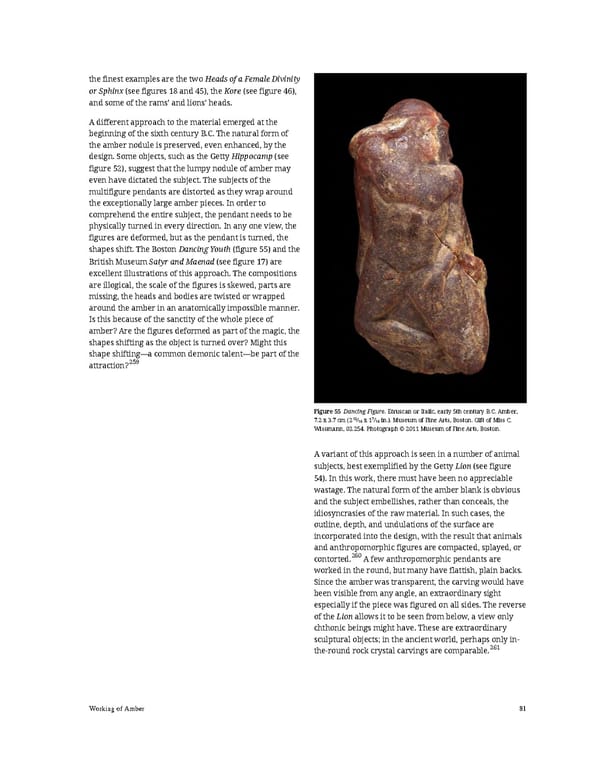the finest examples are the two Heads of a Female Divinity or Sphinx (see figures 18 and 45), the Kore (see figure 46), and some of the rams’ and lions’ heads. A different approach to the material emerged at the beginning of the sixth century B.C. The natural form of the amber nodule is preserved, even enhanced, by the design. Some objects, such as the Getty Hippocamp (see figure 52), suggest that the lumpy nodule of amber may even have dictated the subject. The subjects of the multifigure pendants are distorted as they wrap around the exceptionally large amber pieces. In order to comprehend the entire subject, the pendant needs to be physically turned in every direction. In any one view, the figures are deformed, but as the pendant is turned, the shapes shift. The Boston Dancing Youth (figure 55) and the British MuseumSatyr and Maenad(seefigure 17) are excellent illustrations of this approach. The compositions are illogical, the scale of the figures is skewed, parts are missing, the heads and bodies are twisted or wrapped around the amber in an anatomically impossible manner. Is this because of the sanctity of the whole piece of amber? Are the figures deformed as part of the magic, the shapes shifting as the object is turned over? Might this shape shifting—a common demonic talent—be part of the attraction?259 Figure 55 Dancing Figure. Etruscan or Italic, early 5th century B.C. Amber, 7.2 x 3.7 cm (213⁄16 x 17⁄16 in.). Museum of Fine Arts, Boston. Gift of Miss C. Wissmann, 02.254. Photograph © 2011 Museum of Fine Arts, Boston. A variant of this approach is seen in a number of animal subjects, best exemplified by the Getty Lion (see figure 54). In this work, there must have been no appreciable wastage. The natural form of the amber blank is obvious and the subject embellishes, rather than conceals, the idiosyncrasies of the raw material. In such cases, the outline, depth, and undulations of the surface are incorporated into the design, with the result that animals and anthropomorphic figures are compacted, splayed, or contorted.260 A few anthropomorphic pendants are worked in the round, but many have flattish, plain backs. Since the amber was transparent, the carving would have been visible from any angle, an extraordinary sight especially if the piece was figured on all sides. The reverse of the Lion allows it to be seen from below, a view only chthonic beings might have. These are extraordinary sculptural objects; in the ancient world, perhaps only in- the-round rock crystal carvings are comparable.261 Working of Amber 81
 Ancient Carved Ambers in the J. Paul Getty Museum Page 90 Page 92
Ancient Carved Ambers in the J. Paul Getty Museum Page 90 Page 92